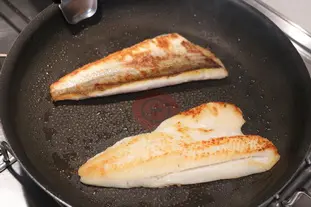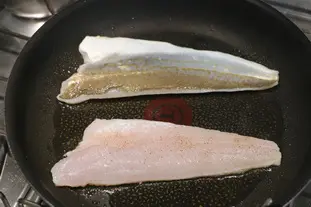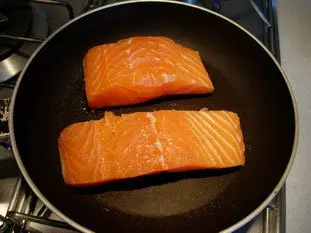The skin side of the fish first?

When it comes to cooking fresh fish, if it's filleted with its skin on and you're planning to pan-fry it in a little olive oil, for example, you might ask yourself the following question: Which side, skin or flesh, should come into contact with the pan first?
26 K 4.4/5 (19 reviews)
Keywords for this post:FishCookingSkinFleshTipLast modified on: February 13th 2021
The skin side of the fish first?
You will probably read here or there that it is always the skin side first, we always grill longer on that side, and first, because we often want to get a nice crispness, when the skin is eaten, for whiting or sea bass for example.
This is often true, and for thick filleted fish, salmon for example, it allows to remove it quite easily once its side is cooked.
But for some thin fish, it is not always interesting: the skin stretches brutally in contact with the pan, and deforms the fillet into a bow.
This is very pronounced for red mullet, for example. It doesn't change the taste of the fish, but it makes it look a little less appetizing.
But if you start with the flesh side, the skin will not reach the desired crispness, or else with the risk that the fish is a bit overcooked.
You will notice at this point that even if the skin is still tense, the flesh, just seized, is much better, and your fillet does not deform, or less.
If necessary (fillet a little thick) finish with a third, short turn, on the flesh side, to finish browning well.
Another possible solution is to scarify the skin side over a few millimetres deep with a small, very sharp knife to prevent it from shrinking.
To sum up: For fine fish fillets whose skin is to be eaten, first cook the flesh side for 30 seconds, then cook the skin side normally.

This is often true, and for thick filleted fish, salmon for example, it allows to remove it quite easily once its side is cooked.

But for some thin fish, it is not always interesting: the skin stretches brutally in contact with the pan, and deforms the fillet into a bow.
This is very pronounced for red mullet, for example. It doesn't change the taste of the fish, but it makes it look a little less appetizing.
But if you start with the flesh side, the skin will not reach the desired crispness, or else with the risk that the fish is a bit overcooked.
What to do?
Try to proceed in 2 times at least: Frying pan quite hot, put your fillet on the flesh side first, let cook 30 seconds, just to seize, turn over (skin side down this time), and cook the necessary time.You will notice at this point that even if the skin is still tense, the flesh, just seized, is much better, and your fillet does not deform, or less.

If necessary (fillet a little thick) finish with a third, short turn, on the flesh side, to finish browning well.
Another possible solution is to scarify the skin side over a few millimetres deep with a small, very sharp knife to prevent it from shrinking.
To sum up: For fine fish fillets whose skin is to be eaten, first cook the flesh side for 30 seconds, then cook the skin side normally.
Lasts posts
Oven height
When we put a dish or cake in the oven, we naturally tend to put it on the middle shelf, and that's what we usually do. But in some cases, this position and height can be a little tricky, so let's find out why.October 8th 20251,3315
The importance of sieving
In recipes that use a fine powder (flour, powdered sugar, etc.), you'll often see the advice to sift before using it. To sift is to pass the powder in question through a sieve (a very fine strainer) before incorporating it into your recipe. It's often advice, but is it really useful?September 3rd 20256,8243
The grease spray
As soon as you have something in a recipe that sticks to the mold, the question always arises as to how difficult it is to remove from the mold. There's nothing more frustrating than breaking your cake when unmolding it, because part of it has stuck in the mold. The classic way to avoid this is...August 26th 20256,2625
Cake moulds
When we make a cake, or a cake of the same rectangular shape, we usually take out our usual mould and tell ourselves that the recipe is anyway "for a cake", but is it really that simple?August 25th 20256,3655
Thinning out herbs
If you need to add a long-stemmed herb (tarragon, mint, verbena, thyme, etc.) to a recipe, you'll probably only need the leaves and not the stem, so you'll need to remove the leaves. Leaf removal means keeping only the beautiful leaves, and eliminating the ugly stems and leaves, but how do you do...August 8th 20254,5095
Other pages you may also like
The so-called "nervous" meats
You've probably heard this before, we're talking about "nervous" meat, or meat with nerves, to describe what is indicated by the blue arrow on the left. This is a piece of beef, and what we call a nerve is not a nerve, it is in fact collagen (chemists sometimes call it a "collagen sink"), a...April 16th 202135 K4.5
A few tips for effective kneading at home
When you have to knead dough for bread or some other recipe, you may well use a food processor or the type of machine known as a stand mixer. The best-known brands are Kenwood and KitchenAid. They are useful tools, but here are a few tips to help you get the best out of them.June 23th 2021282 K 23.8
Egg yolks and caster sugar
We often come across recipes where we need to mix egg yolks with caster sugar. This would appear to be a very ordinary and simple thing to do but, be warned, these two ingredients can behave oddly together.February 15th 201881 K 24.3
Drawing a pattern in pastry
Often in the kitchen, in pastry-making, or in baking, we need to trace a pattern on a pastry. It's just a question of aesthetics but it has its effect after baking on a galette, pithiviers, pâté en croute (terrine in a pie crust), etc.May 23th 201934 K4.1
Remove bones from fish
Let's talk about fish: It's not a scoop, it's much more pleasant to eat fish from which all the bones have been carefully removed, even if it's a rather painful and time-consuming job, the result is worthy of your efforts. Here are some important points to keep in mind.October 16th 202114 K5
Post a comment or question
Follow this page
If you are interested in this page, you can "follow" it, by entering your email address here. You will then receive a notification immediately each time the page is modified or a new comment is added. Please note that you will need to confirm this following.
Note: We'll never share your e-mail address with anyone else.
Alternatively: you can subscribe to the mailing list of cooling-ez.com , you will receive a e-mail for each new recipe published on the site.









